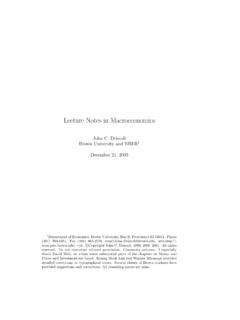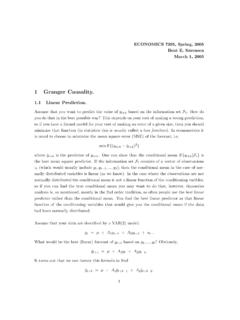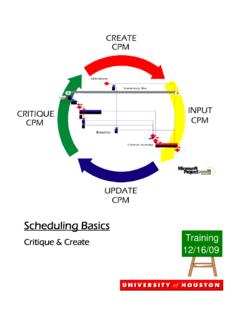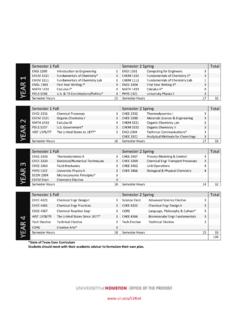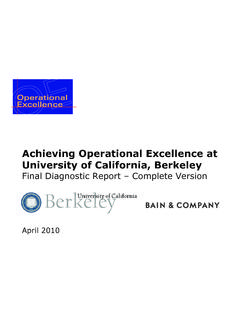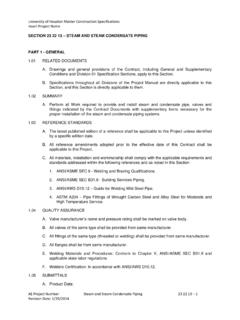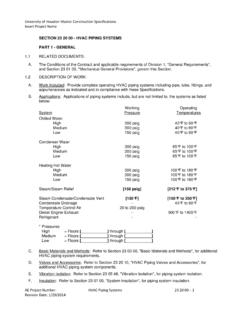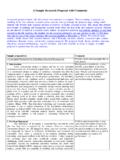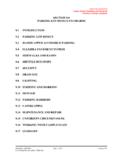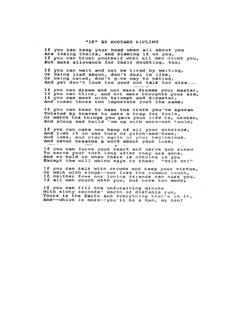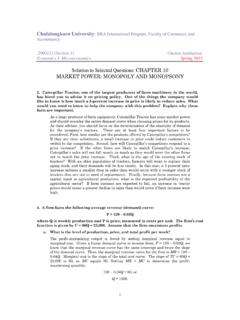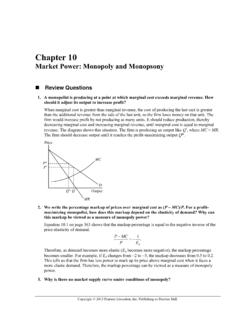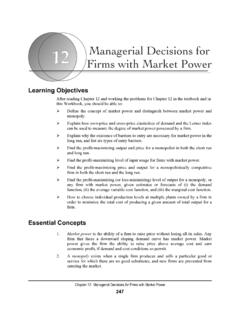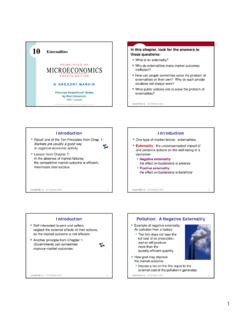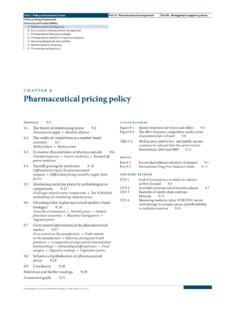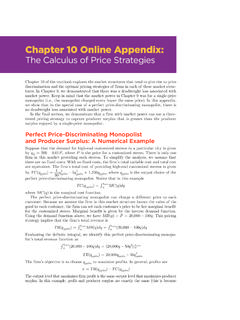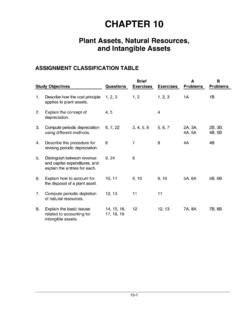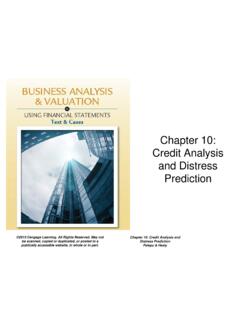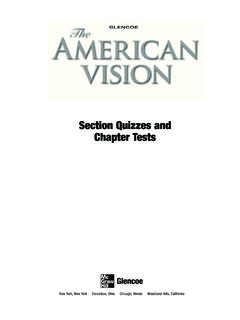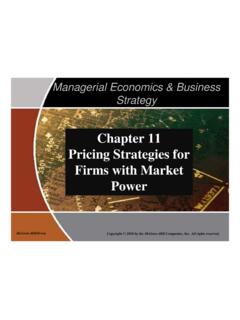Transcription of CHAPTER 11 PRICING WITH MARKET POWER
1 CHAPTER 11: PRICING with MARKET POWER 139 CHAPTER 11 PRICING with MARKET POWER EXERCISES 2. True. Approach this question as a two-part tariff problem where the entry fee is a charge for the car plus the driver and the usage fee is a charge for each additional passenger other than the driver. Assume that the marginal cost of showing the movie is zero, , all costs are fixed and do not vary with the number of cars. The theater should set its entry fee to capture the consumer surplus of the driver, a single viewer, and should charge a positive price for each passenger. 4. a. with separate markets, BMW chooses the appropriate levels of QE and QU to maximize profits, where profits are: =TR TC=QEPE+QUPU() QE+QU()15+20,000{}.
2 Solve for PE and PU using the demand equations, and substitute the expressions into the profit equation: =QE45 QE400 +QU55 QU100 QE+QU()15+20,000{}. Differentiating and setting each derivative to zero to determine the profit-maximizing quantities: or carsQQQEEE= ==452001506000,, and QQ or Q ==55501502,000, Substituting QE and QU into their respective demand equations, we may determine the price of cars in each MARKET : 6,000 = 18,000 - 400PE, or PE = $30,000 and 2,000 = 5,500 - 100PU, or PU = $35,000. Substituting the values for QE, QU, PE, and PU into the profit equation, we have = {(6,000)(30) + (2,000)(35)} - {(8,000)(15)) + 20,000}, or = $110,000,000. b.
3 If BMW charged the same price in both markets, we substitute Q = QE + QU into the demand equation and write the new demand curve as Q = 23,500 - 500P, or in inverse for as PQ= 47500. Since the marginal revenue curve has twice the slope of the demand curve: MRQ= 47250. To find the profit-maximizing quantity, set marginal revenue equal to marginal cost: CHAPTER 11: PRICING with MARKET POWER 1404725015 =Q, or Q* = 8,000. Substituting Q* into the demand equation to determine price: P=47 8,000500 =$31,000. Substituting into the demand equations for the European and American markets to find the quantity sold QE = 18,000 - (400)(31), or QE = 5,600 and QU = 5,500 - (100)(31), or QU = 2,400. Substituting the values for QE, QU, and P into the profit equation, we find = {(5,600)(31) + (2,400)(31)} - {(8,000)(15)) + 20,000}, or = $108,000,000.
4 5. with price discrimination, the monopolist chooses quantities in each MARKET such that the marginal revenue in each MARKET is equal to marginal cost. The marginal cost is equal to 3 (the slope of the total cost curve). In the first MARKET 15 - 2Q1 = 3, or Q1 = 6. In the second MARKET 25 - 4Q2 = 3, or Q2 = Substituting into the respective demand equations, we find the following prices for the two markets: P1 = 15 - 6 = $9 and P2 = 25 - 2( ) = $14. Noting that the total quantity produced is , then = ((6)(9) + ( )(14)) - (5 + (3)( )) = $ The monopoly deadweight loss in general is equal to DWL = ( )(QC - QM)(PM - PC ). Here, DWL1 = ( )(12 - 6)(9 - 3) = $18 and DWL2 = ( )(11 - )(14 - 3) = $ Therefore, the total deadweight loss is $ Without price discrimination, the monopolist must charge a single price for the entire MARKET .
5 To maximize profit, we find quantity such that marginal revenue is equal to marginal cost. Adding demand equations, we find that the total demand curve has a kink at Q = 5: P= 25 2Q, if Q 5 , if Q>5 . This implies marginal revenue equations of MR= 25 4Q, if Q 5 , if Q>5 . CHAPTER 11: PRICING with MARKET POWER 141 with marginal cost equal to 3, MR = - is relevant here because the marginal revenue curve kinks when P = $15. To determine the profit-maximizing quantity, equate marginal revenue and marginal cost: - = 3, or Q = Substituting the profit-maximizing quantity into the demand equation to determine price: P = - ( )( ) = $ with this price, Q1 = and Q2 = (Note that at these quantities MR1 = and MR2 = ).
6 Profit is ( )( ) - (5 + (3)( )) = $ Deadweight loss in the first MARKET is DWL1 = ( )( )( ) = $ Deadweight loss in the second MARKET is DWL2 = ( )( )( ) = $ Total deadweight loss is $ Note it is always possible to observe slight rounding error. with price discrimination, profit is higher, deadweight loss is smaller, and total output is unchanged. This difference occurs because the quantities in each MARKET change depending on whether the monopolist is engaging in price discrimination. *6. a. To find the profit-maximizing price, first find the demand curve in inverse form: P = 500 - Q. We know that the marginal revenue curve for a linear demand curve will have twice the slope, or MR = 500 - 2Q.
7 The marginal cost of carrying one more passenger is $100, so MC = 100. Setting marginal revenue equal to marginal cost to determine the profit-maximizing quantity, we have: 500 - 2Q = 100, or Q = 200 people per flight. Substituting Q equals 200 into the demand equation to find the profit-maximizing price for each ticket, P = 500 - 200, or P = $300. Profit equals total revenue minus total costs, = (300)(200) - {30,000 + (200)(100)} = $10,000. Therefore, profit is $10,000 per flight. b. An increase in fixed costs will not change the profit-maximizing price and quantity. If the fixed cost per flight is $41,000, EA will lose $1,000 on each flight. The revenue generated, $60,000, would now be less than total cost, $61,000.
8 Elizabeth would shut down as soon as the fixed cost of $41,000 came due. CHAPTER 11: PRICING with MARKET POWER 142300500200250300305400500 QPDAC1AC2 Figure c. Writing the demand curves in inverse form, we find the following for the two markets: PA = 650 - and PB = 400 - Using the fact that the marginal revenue curves have twice the slope of a linear demand curve, we have: MRA = 650 - 5QA and MRB = 400 - To determine the profit-maximizing quantities, set marginal revenue equal to marginal cost in each MARKET : 650 - 5QA = 100, or QA = 110 and 400 - = 100, or QB = 90. Substitute the profit-maximizing quantities into the respective demand curve to determine the appropriate price in each sub- MARKET : PA = 650 - ( )(110) = $375 and PB = 400 - ( )(90) = $250.
9 When she is able to distinguish the two groups, Elizabeth finds it profit-maximizing to charge a higher price to the Type A travelers, , those who have a less elastic demand at any price. CHAPTER 11: PRICING with MARKET POWER 143260520400650QP240 Figure d. with price discrimination, total revenue is (90)(250) + (110)(375) = $63,750. Total cost is 41,000 + (90 + 110)(100) = $61,000. Profits per flight are = 63,750 - 61,000 = $2,750. Consumer surplus for Type A travelers is ( )(650 - 375)(110) = $15,125. Consumer surplus for Type B travelers is ( )(400 - 250)(90) = $6,750 Total consumer surplus is $21,875. e. When price was $300, Type A travelers demanded 140 seats; consumer surplus was ( )(650 - 300)(140) = $24,500.
10 Type B travelers demanded 60 seats at P = $300; consumer surplus was ( )(400 - 300)(60) = $3,000. Consumer surplus was therefore $27,500, which is greater than consumer surplus of $21,875 with price discrimination. Although the total quantity is unchanged by price discrimination, price discrimination has allowed EA to extract consumer surplus from those passengers who value the travel most. 8. a. We know that a monopolist with two markets should pick quantities in each MARKET so that the marginal revenues in both markets are equal to one another and equal to marginal cost. CHAPTER 11: PRICING with MARKET POWER 144 Marginal cost is $30 (the slope of the total cost curve).
